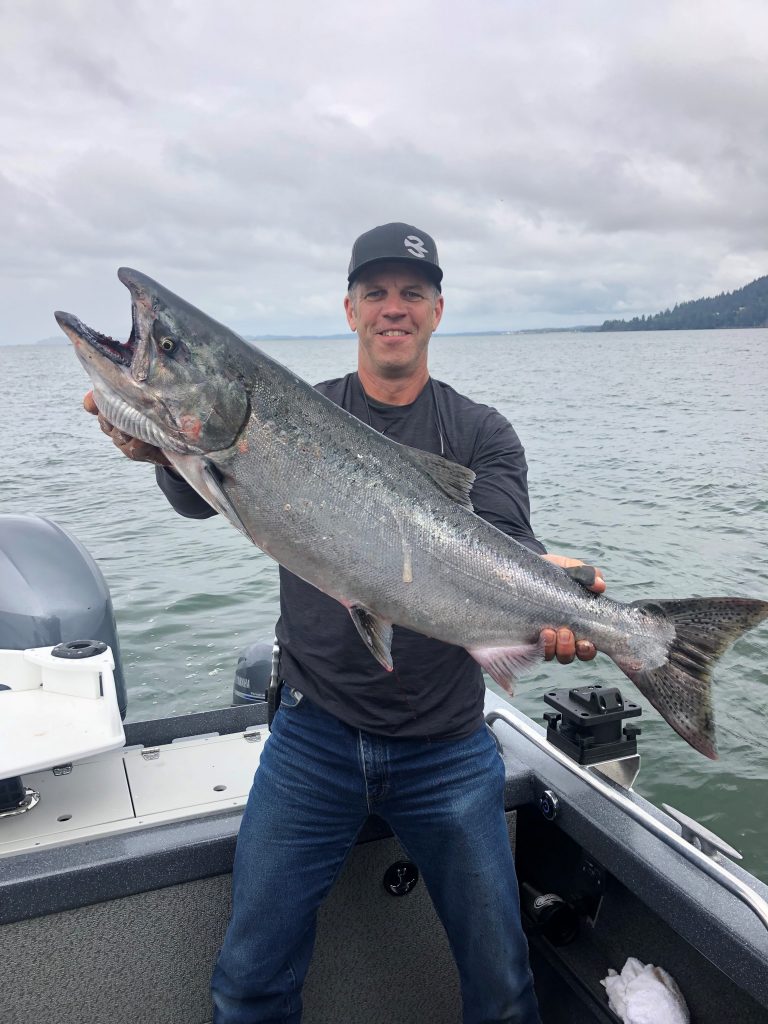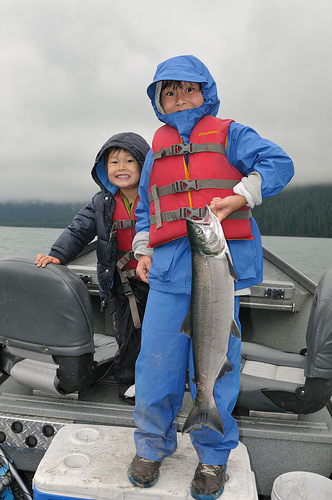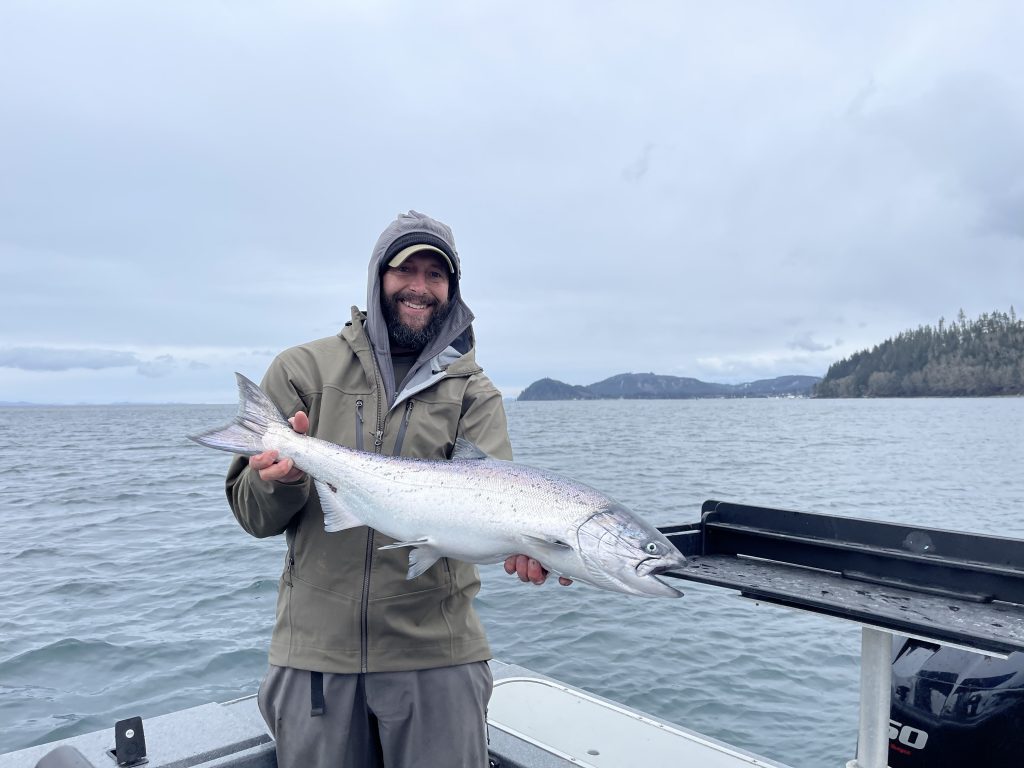Washington salmon fishing seasons in 2024-2025 are similar to last season along with added time on the water in several areas for coho and sockeye Leave a reply

Contributed by Mark Yuasa, WDFW
SEATTLE – The Pacific Fishery Management Council week-long meeting wrapped up on Thursday, April 11, thus setting the tentative salmon fishing seasons and anglers should find statewide opportunities that’ll likely mirror last season.
That long winding road in the two-month season-setting process known as North of Falcon, is a term referring to waters north of Oregon’s Cape Falcon, which marks the southern border of management of Washington’s salmon stocks. During this process, state and tribal fishery managers use a suite of scientific data, including watershed sampling and monitoring, ocean indicators, and previous year returns, to estimate the number of salmon returning and decipher how many fish are available to catch.
The highlight for the Puget Sound region will likely be another strong sockeye return to the Baker River where the forecast is 56,750 in 2024 up from a 2023 forecast of 31,296 and an in-season estimate of 65,000. Other forecast comparisons include 27,081 in 2022, 12,253 in 2021, 13,242 in 2020; and 33,737 in 2019. The all-time low occurred in 1985 when less than 100 sockeye returned to the Baker River.
The 2024 Baker sockeye forecast is up 57% over the recent 10-year average and will allow a harvest split on sockeye for Baker Lake and the Skagit River at 75%/25% respectively.

This will allow the Skagit River from Mount Vernon Memorial Highway Bridge to the Dalles Bridge at Concrete to open for sockeye June 16 through July 15 with a four sockeye only daily limit. Baker Lake will open July 6 through Aug. 31 with a four-sockeye daily limit; each angler aboard a vessel may deploy salmon angling gear until the daily limit for all anglers aboard has been achieved. Fishing will open July 6 regardless of number of sockeye present in the lake and be sure to check the trap counts to decide when to go fishing on the WDFW webpage.
Refer to the WDFW blog post about the recent success of Baker River sockeye. This effective collaboration, communication, and trust between Skagit River sockeye co-manager Tribes, WDFW, and Puget Sound Energy over the past decade, has built a strong foundation for Baker Lake sockeye recovery.
Others are eagerly awaiting what is expected to be another strong 2024 Columbia River sockeye forecast of 401,700, which is up 16% over the recent 10-year average, and if all pans out will create a back-to-back years of success for anglers to target sockeye in open waters of the Columbia River. The Okanogan River sockeye forecast of 288,700 is up from 187,400 and an actual return of 179,655 in 2023.
Many of these sockeye linger in the Brewster Pool, a popular summer deep-water salmon fishing location on Upper Columbia.
Sockeye migrate from its confluence just below Chief Joseph Dam, north into its headwater lakes in British Columbia that is known for a notoriously warm water barrier and changing river flow patterns in the summer. In 2023 and 2022, colder water throughout the mid- and upper-Columbia had sockeye darting straight up into the Brewster Pool generating good fishing in early summer and into August.

The summer-migrating sockeye are learning to adapt their upstream migration timing in recent years therefore most fish returns are peaking sooner than later in the summer. Over the past few decades, the run would peak by early July, but it’s shifted to late June and has resulted in higher sockeye survival in recent seasons.
Another bright spot to keep tabs on is a Lake Wenatchee sockeye salmon forecast is 97,000 up from a 44,300 forecast in 2023 and the actual return was 146,875. The management objective is 23,000 sockeye at Tumwater Dam. The lake could provide a late-summer sport fishery if the objective is met.
While in-river fisheries are also tentatively set, WDFW fishery managers are concerned over the current low mountain snowpack, which brings the potential for drought conditions, high water temperatures and low water level issues in rivers. These conditions could impact freshwater sport fisheries and salmon migration in late summer and early fall timeframe. Winter flooding also has the potential for impacts on future salmon runs.
As climate change impacts Washington’s watersheds and ecosystems WDFW will monitor impacts and may need to adopt in-season management changes to address these conditions.
Salmon fishing opportunities in 2024-2025
WDFW fishery managers aligned several Puget Sound marine area summer Chinook fisheries to begin on the same date of July 18 to spread out fishing pressure in Marine Area 7 (San Juan Islands), Marine Area 9 (Admiralty Inlet), Marine Area 10 (Seattle/Bremerton Area), and Marine Area 11 (Tacoma-Vashon Island) along with area-specific catch guidelines. Marine Area 11 is also open Wednesdays to Saturdays only from June 5–30 with area-specific catch guidelines.

A summer hatchery-marked Chinook fishery in the San Juan Islands (Marine Area 7) is open July 18-20. Fishing will be open Thursdays to Saturdays. This allows WDFW to assess the fisheries on a weekly basis to see if additional days can be added after the initial opener. In Marine Area 7, once the 2,181 Chinook quota is achieved (2,181 in 2023, 1,800 in 2022, 1,382 in 2021 and 1,562 in 2020) along with a total unmarked encounter of 3,845 and 2,141 total sublegal encounter. On days when Chinook fishing is closed in July it will remain open for hatchery coho, and also open daily from Aug. 1-31 for hatchery coho only. Fishing reverts to non-selective coho from Sept. 1-29 with a daily limit increase of two coho.
A summer hatchery-marked Chinook fishery in northern Puget Sound (Marine Area 9) is open July 18-20 with a chance to reopen July 25-27. WDFW will assess after the three-day fishery to see if additional time can be added. There is a 3,900 Chinook quota (4,300 in 2023, 4,700 in 2022 and 2021 and 5,600 in 2020). Marine Area 9 is open for hatchery coho is Aug. 1-Sept. 23 and non-selective coho from Sept. 24-30.
In central Puget Sound (Marine Area 10) the fishery targeting coho only opens June 5 through Oct. 15. The hatchery-marked Chinook fishery is open Thursdays through Saturdays only from July 18-31 although retaining hatchery Chinook could close sooner if the 3,166 quota is achieved (3,566 in 2023, 3,966 in 2022, 3,718 in 2021 and 4,100 in 2020) along with a 6,477 total sublegal encounter.
South central Puget Sound (Marine Area 11) opens Wednesdays through Saturdays only for hatchery-marked Chinook will open June 5-30 with a catch quota of 1,423, a total unmarked encounter of 910, and a total sublegal encounter of 2,608. The Chinook fishery reopens Thursdays through Saturdays only beginning July 18 with a remaining summer quota is 3,379 (3,379 in 2023, 2,816 in 2022 and 2,656 in 2021), a total unmarked encounter of 5,907 and a total sublegal encounter of 840. Marine Area 11 is open for coho only from Oct. 1 through Nov. 15.

In the Strait of Juan de Fuca, Sekiu (Marine Area 5) opens July 1 through Aug. 15 for hatchery-marked Chinook and hatchery-marked coho, and the Chinook fishery could close sooner if the 6,539 legal size encounter guideline is achieved (3,906 in 2023, 3,890 in 2022 and 4,077 in 2021). Marine Area 5 will have a non-selective coho fishery beginning Sept. 27 to Oct. 15 with an increased daily limit of two coho.
The eastern Strait of Juan de Fuca, Port Angeles (Marine Area 6) – west of a true north/south line through the #2 Buoy immediately east of Ediz Hook – opens July 1 through Aug. 15 for hatchery-marked Chinook and hatchery-marked coho, and the Chinook fishery could close sooner if the 11,173 legal size encounter guideline is achieved (5,258 in 2023, 6,050 in 2022 and 4,769 in 2021). The area east of the boundary is open July 1 through Sept. 26 for hatchery-marked coho only. Marine Area 6 will have a non-selective coho fishery beginning Sept. 27 to Oct. 15 with an increased daily limit of two coho.
Fishing in Marine Area 8–1 (Deception Pass, Hope Island, and Skagit Bay) is open for non-selective coho from Aug. 1 through Oct. 13, and Marine Area 8–2 (Port Susan and Port Gardner) is open for non-selective coho from Aug. 1 through Sept. 24.
In southern Puget Sound (Marine Area 13) fishing is open year-round for salmon. From July 1 to Sept. 30 the hatchery chinook minimum size limit is 20 inches; release wild coho and wild chinook and all chum. From May 15 to June 30 and Oct. 1 to May 14 of 2024 the hatchery chinook minimum size limit is 22 inches; release wild coho and wild chinook and all chum.
Hood Canal south of Ayock Point (Marine Area 12) opens July 11 to Sept. 30 for coho and hatchery Chinook and opens from Oct. 1-31 for coho only and release chum through Oct. 15 and open Nov. 1-30 for chum only. Hood Canal north of Ayock Point is open Aug. 1 to Oct. 31 for a fishery directed at coho only and release chum from through Oct. 15. Fishing is open for chum only from Nov. 1-30.
Coastal salmon fisheries
The ocean salmon fisheries reflect forecasts for Columbia River Chinook that are similar to 2023. The number of hatchery coho expected to return to the Columbia River is lower than 2023 but should provide good opportunities.
WDFW fishery managers agreed during this week’s PFMC meeting to recreational ocean quotas of 41,000 Chinook and 79,800 marked coho.
Marine Area 4 (Neah Bay), Marine Area 3 (La Push), and Marine Area 1 (Ilwaco) will open for salmon retention beginning June 22. Marine Area 2 (Westport-Ocean Shores) opens June 30-July 11 on Sundays through Thursdays only, and then open daily beginning July 14. Marine Areas 2, 3, and 4 are scheduled to remain open until Sept. 15 or until quotas are met. Marine Area 1 is scheduled to remain open until Sept. 30 or until quotas are met. Species and size restrictions are dependent on the area.

The sub-area quotas are — Marine Area 4, 8,300 hatchery-marked coho and 9,430 Chinook. Marine Area 3, 2,07 hatchery-marked coho and 1,630 Chinook. Marine Area 2, 29,530 hatchery-marked coho and 17,430 Chinook. Marine Area 1, 39,900 hatchery-marked coho and 12,510 Chinook.
Columbia River salmon fishing options
Summer Chinook salmon fisheries on the Columbia River are expected to have fewer retention opportunities than 2023, with fishing planned to be open June 16–19 from the Astoria-Megler Bridge to Bonneville Dam. Bonneville Dam to Priest Rapids Dam will open June 16–30 and closed to retention thereafter. Sockeye retention is expected to be allowed in the daily salmonid bag limit from June 16-July 31 for waters downstream of Highway 395 Bridge in Pasco.
Columbia River fall fisheries from Buoy 10 to the Highway 395 Bridge in Pasco are planned for an Aug. 1 opener, with different dates by area for Chinook and coho. This includes steelhead restrictions throughout the river. The coho run size is expected to be lower than in recent years but should provide similar fishing opportunities. The Chinook run size is less than last year’s return but is still expected to provide good fishing opportunities.

Other nibbles and bites
- Puget Sound winter Chinook salmon fisheries have been modeled to begin March 1 through April 30 for Marine Area 5, Marine Area 10, and Marine Area 11. Various catch estimates will base the length of the season for each marine area. WDFW fishery managers will be in discussion with sport fishing advisers and the public to decide start dates for all three marine areas.
- There will also be a small window of opportunity in inner-Elliott Bay from Aug. 2-5 and additional openings may occur depending on in-season updates.
- The Tulalip Bubble Fishery will open for Chinook fishing from May 24 through Sept. 2 and allowed from 12:01 a.m. Fridays through Mondays of each week. Fishing is closed on June 1 for the Tulalip Tribal fishing ceremony. Fishing is also open Sept. 7–22 and allowed Saturdays and Sundays of each.
- Sinclair Inlet is open July 16 through Sept. 30 (two-pole endorsement is allowed) with a three-salmon daily limit, release chum and wild Chinook.
- The overall Puget Sound chum salmon population has seen an improvement compared to the past couple of years. WDFW has a Puget Sound chum salmon recreational fishing opportunities in Marine Area 10 (Seattle/Bremerton Areas) and Marine Area 11 (Tacoma-Vashon Island) from Oct. 1 through Nov. 15. Any proposed chum fishing in Marine Area 13 (South Puget Sound) will be based on in-season management.
- The Cascade River and the Skagit River from the Highway 530 Bridge at Rockport to the Cascade River Road is open May 29 through July 15 for hatchery-marked spring Chinook.
- Due to an expected low coho salmon forecast, WDFW reached an agreement to implement a hatchery-marked selective coho fishery along with a three-fish bag limit in the Quillayute River located on the northern Olympic Coast from Sept. 1 through Dec. 15.
- For the proposed 2024–2025 Puget Sound marine area and freshwater fisheries, Columbia River fisheries and ocean water fisheries, refer to the WDFW season summaries and agreed fisheries webpage. Note these are tentative salmon fishing seasons and regulations and they could change until final regulations are adopted sometime in early June.
- There will be an online WDFW joint Willapa Bay/Grays Harbor final fisheries package meeting at 6 p.m. on Tuesday, April 16. Topics of discussion include post-NOF review of the outcome of regulations and schedules for the 2024–25 fishing season. To register, go to this registration link.
- For salmon season setting process materials and video presentations from all the meetings, refer to the NOF public meeting webpage. Visit our WDFW North of Falcon FAQs and Glossary Information for helpful key terms and suggested resources.
- Due to an expected low coho salmon forecast, WDFW reached an agreement to implement a hatchery-marked selective coho fishery along with a three-fish bag limit in the Quillayute River located on the northern Olympic Coast from Sept. 1 through Dec. 15.
- For the proposed 2024–2025 Puget Sound marine area and freshwater fisheries, Columbia River fisheries and ocean water fisheries, refer to the WDFW season summaries and agreed fisheries webpage. Note these are tentative salmon fishing seasons and regulations and they could change until final regulations are adopted sometime in early June.
- There will be an online WDFW joint Willapa Bay/Grays Harbor final fisheries package meeting at 6 p.m. on Tuesday, April 16. Topics of discussion include post-NOF review of the outcome of regulations and schedules for the 2024–25 fishing season. To register, go to this registration link.
- For salmon season setting process materials and video presentations from all the meetings, refer to the NOF public meeting webpage. Visit our WDFW North of Falcon FAQs and Glossary Information for helpful key terms and suggested resources.
- As part of the 2024-25 salmon season setting process, WDFW created the “Salmon Daily Digest” blog. This blog provided regular updates of the ongoing developments during this process, known as the North of Falcon, which refers to waters north of Oregon’s Cape Falcon and marks the southern border of management of the state’s salmon stocks, including Puget Sound, Strait of Juan de Fuca, Columbia River, and coastal areas. Within the blog are the key developments from the 18 posts that were listed by dates for each of the meetings.
- The WDFW news release on the salmon fishing seasons can be found by going to this link on the WDFW website.
(Mark Yuasa is a Washington Department of Fish and Wildlife Communications Manager. He also has contributed numerous blogs to the KIRO/ESPN The Outdoor Line and was the outdoor reporter at The Seattle Times for 28 years.)

